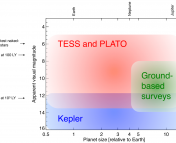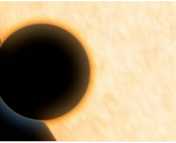- Title: Precision multi-band photometry with a DSLR camera
- Authors: M. Zhang et al.
- First Author’s Institution: Princeton University
Do you own a digital single-lens reflex (DSLR) camera? It’s the cameras commonly seen in the enthusiastic hands of photographers and tourists. The authors of today’s paper do. Their tourist attraction was the stars in sky. They used their camera for astronomy. They used their camera for science.
The authors wanted to answer the question: “Can consumer DSLR cameras be used for precision photometry from the ground? Can we use them to hunt for planets with the transit method?”
The short answer is, yes, you can.
DSLR: An everyday item for planet hunting
Chances are you have heard of Kepler, the space mission. It uses the transit method to find planets. Kepler has found many of them. Thousands. SuperWASP, HATNet, and KELT are also transit surveys to find exoplanets, but they are run from the ground. Their transit-hunting strategy is similar to the Kepler mission: they look at a large field of view and measure the brightnesses of about 100,000 stars at a time. If a star periodically dips in brightness we have a planet candidate. Collectively, the latter three surveys have discovered around two hundred transiting exoplanets. They are less precise than Kepler, and are really only able to find the biggest, closest-to-the-star planets called Hot Jupiters. They are, however, much less expensive than Kepler. But could they be made even less expensive?
Traditionally, ground based transit surveys use research-grade Charged Coupled Device (CCD) imaging detectors to record their observations. They can cost about 10,000 USD / 6400 €. This is a significant obstacle for the creation of new exoplanet transit surveys, or the expansion of existing ones, as such surveys require a handful of telescopes to monitor the sky effectively. HATNet for example is composed of 7 telescopes. The authors’ idea to lowering the startup costs was look for cheaper alternatives to CCDs.
Enter the commercial DSLR camera detectors, called complimentary metal-oxide-semiconductor (CMOS) detectors. These devices have excellent electronic characteristics for their price, driven largely by the demands of the enthusiastic hands. Additionally, DSLRs have the interesting capability of recording three colors simultaneously, while CCDs only see in black and white. DSLR cameras do this with the help of a Bayer filter—a filter with a specific RGB color pattern (see Figure 1)—which sits on top of the CMOS detector. By adding the different color channels together, a broad range of colors can be reproduced. We expect to get the highest brightness precision using the total combined light, but studying the different color channels individually provides an interesting option for simultaneous multicolor photometry. Why not try to use DSLRs to find planets?

Figure 1: A Bayer filter pattern with 4 color channels, numbered 0, 1, 2, 3, enables DSLR cameras to see in color. Each square represents one pixel on the detector. Figure 2 from the paper.
The authors did. Figure 2 shows their setup: a Canon EOS 60D attached to HAT10, one of the telescope units part of HATNet. The HAT unit itself is a fully automated observatory consisting of a telephoto lens and a CCD. The mount sits inside a small clamshell dome equipped with weather sensors which tell the dome to close during the day and when weather deteriorates.

Figure 2: The inside of the HAT10 telescope unit. The mount holds a CCD, and a large telephoto lens. On the right is the piggybacked Canon EOS 60D DSLR camera with a 135mm f/2 lens. Figure 1 from the paper.
Comparing the DSLR to the CCD—can the former find transiting planets?
The authors had two goals in mind. First, they wanted to compare the performance of the DSLR to the CCD. Second, they wanted to see if the former could find transiting planets.
The authors therefore observed the same field repeatedly using both cameras simultaneously, and took exposures of same length with both. In total, they gathered 4600 frames of the field from February 22 to May 30 inclusive. They had a good reason to choose this field: it was high in the night sky in February, and contains a known transiting exoplanet, KELT-3b. Could they recover it with the DSLR? Could they find other planets too?
Finding a planet
The authors analyze the performance of the DSLR extensively in the paper. In summary, the DSLR performed rather well compared to the CCD. The DSLR reached a precision of 4.6mmag with all color channels combined (mmag, or milli-magnitude is a measure of brightness), which is not much worse than the 3-4mmag the CCD achieved.
With this precision the authors found four planet candidates in the field G180. One of them KELT-3b. The lightcurve of the planet is shown in Figure 3. A clear transit signal is seen. Regretfully, follow up with the other three candidates showed that they were all false alarms.

Figure 3: Lightcurve of KELT-3 using the DSLR with all color channels combined. A transit signal can clearly be seen. Figure 13 from the paper.
Regardless, this is an interesting result. The authors show that DSLRs are a cheap, and lightweight option capable of finding planets with the transit method. DSLRs are improving at a very rapid pace; each generation is getting better and better. This opens up an array of low-cost options for ground based transit surveys: a spark for their expansion.





Just as a reference from past: http://www.astrosurf.com/buil/extrasolar/obs.htm
I’m flattered that you thought our paper was interesting enough to write an Astrobites about it 🙂 Your writeup is excellent, and I just have one minor point: for the DSLR, the number of stars we look at simultaneously is closer to 5000. 100,000 stars is about right for HATnet as a whole, though I don’t know the exact number off the top of my head. Also, the way I usually explain mmag is to say 1 mmag = 0.1%, so 3.4 mmag = 0.34% precision. It’s not exactly right, but pretty close and intuitive.
P.S. I think I might have met you in early 2014, when I was visiting Penn State as a prospective. I definitely met Dr. Mahadevan.
–Michael Zhang
Great to hear Michael! Thanks for your comments. I’ll definitely use that explanation to explain mmags—it’s very intuitive. And a small world indeed! Will be happy to talk about the DSLR project if you come by PSU again. Cheers.
What software did you use to get light curve ?
Do you mean the software used for plotting or for the actual retrieval of the light curve? I know that the people at the KELT collaboration generally use AstroImageJ (http://www.astro.louisville.edu/software/astroimagej/) to obtain light curve data points. But that plot itself was generated with Matplotlib on Python.